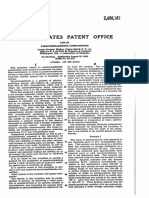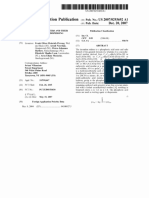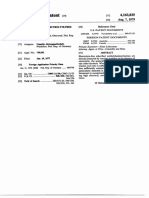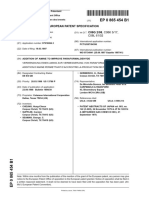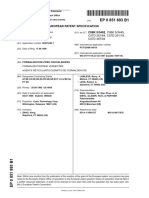United States Patent 0 ": Main, Germany Claims Priority, Application Germany, Aug. 10, 1963
United States Patent 0 ": Main, Germany Claims Priority, Application Germany, Aug. 10, 1963
Uploaded by
هیمن مCopyright:
Available Formats
United States Patent 0 ": Main, Germany Claims Priority, Application Germany, Aug. 10, 1963
United States Patent 0 ": Main, Germany Claims Priority, Application Germany, Aug. 10, 1963
Uploaded by
هیمن مOriginal Title
Copyright
Available Formats
Share this document
Did you find this document useful?
Is this content inappropriate?
Copyright:
Available Formats
United States Patent 0 ": Main, Germany Claims Priority, Application Germany, Aug. 10, 1963
United States Patent 0 ": Main, Germany Claims Priority, Application Germany, Aug. 10, 1963
Uploaded by
هیمن مCopyright:
Available Formats
United States Patent 0 " "we 3,351 ,068
Patented Nov. 7, 1967
l 2
3,351,66? of the cooling liquid is below 120° C., so that the cool
PRUDUCTHUN 0F PARAFGRMALDEHYDE ing liquid still adhering to the paraformaldehyde beads,
Helrnut Jnnirermann and Friedrich Lii?ler, Frankfurt am after separation from the main body of cooling liquid, can
Main, Germany, assignors to Deutsche Golrl- und Sil be removed by evaporation at low temperatures, if de
her-Scheideanstait vorrnals Roessier, Frankfurt am sired, in an air stream or under vacuum with only very
Main, Germany low formaldehyde loss. Examples of suitable cooling
No Bray/ing. Filed July 16, 1964, Scr. No. 383,208 liquids, for instance are: benzene, toluene, cyclohexane or
Claims priority, application Germany, Aug. 10, 1963, ligroin (petroleum ether). After drying the formaldehyde
n erase content of the paraformaldehyde beads produced accord
2 Claims. (Ci. 26®—-615.5)
10 ing to the invention is between 85 and 95%, mostly be
The present invention relates to a process for the pro tween 88 to 92% by weight.
duction of an easily soluble paraformaldehyde product The paraformaldehyde beads produced according to
which is obtained in the ‘form of beads. the invention, in comparison to ?aked paraformaldehyde
In general, paraformaldehyde is produced by the de and other usual commercial paraformaldehyde products,
hydration of aqueous formaldehyde solutions. Such de are distinguished especially by their freedom from dust,
hydration can be carried out by the application of a good ?ow characteristics, high solubility in water and sta
vacuum or by distillation with organic liquids which form bility on aging.
low boiling azeotropic mixtures with water. According The following examples will serve to illustrate the
to other processes partial condensation of formaldehyde process according to the invention.
vapors is involved. 20
In carrying out these processes the so-called formal~ EXAMPLE 1
dehyde-preconcentrate which has about a 70% by weight 107 g. of a formaldehyde preconcentrate with a 76%
and more formaldehyde content is obtained as the product by weight formaldehyde content heated to 106° C. were
of the ?rst dehydration step. Such preconcentrate at the introduced under moderate pressure in a thin stream
temperatures at which it is produced, namely, over 70° into a beaker containing 500 cc. of vigorously stirred ben
C., presents a rather mobile, depending upon its formal zene at 22° C. from a nozzle 1.1 mm. in diameter ar~
dehyde content, more or less clear melt. When such ranged 4 cm. above the upper surface of the benzene.
preconcentrate is cooled to room temperature, again The benzene warmed up to 35° C. during such introduc~
depending upon its formaldehyde content, it forms a more tion. The movement of the benzene caused the stream of
or less viscous, gelatinous to solid opaque mass. The latter, 30 molten preconcentrate to be torn into droplets which
however, cannot be remelted without taking special meas~ solidi?ed and settled to the bottom of the beaker in the
ures. form of beads 0.4 to 1.5 mm. in diameter. After the para
When the production of paraformaldehyde from the formaldehyde beads had been ?ltered off and dried in
preconcentrate is carried out in such a way that the air, 83.6 g. of paraforma-ldehyde with a 90% by weight
further concentration is carried out under higher tem formaldehyde content were obtained.
peratures, large formaldehyde losses occur. This also is EXAMPLE 2
the case when the liquid preconcentrate is allowed to run
over rotating cooled drums, as is customary in the pro 21.5 g. of a formaldehyde preconcentrate with a 80%
duction of paraformaldehyde ?akes, upon which the mass by weight formaldehyde content heated to 103° C. were
solidi?es to a plastic ?lm which can be scraped off. 40 introduced into a thin stream into moderately stirred lig
‘US. Patent 2,704,765 describes a process for the pro roin (B.P. 80 to 100° C.) at 25° C. from a nozzle 1.4
duction of paraformaldehyde in which a gaseous mixture mm. in diameter arranged 12 cm. above the surface of
of 60 to 90% by weight of formaldehyde with inert dil the ligroin. White paraformaldehyde beads were formed
uents such as steam, methanol, methane and/ or carbon which immediately settled to the bottom of the ligroin.
oxides is introduced into a non-solvent organic liquid The supernatant ligroin was poured oif and the beads
which serves as a cooling medium and also contains 45 dried. 17.0 g. of paraformaldehyde with a formaldehyde
a basic or acid reacting substance as a condensation cat content of 88.5% by weight were obtained.
alyst. In this instance the paraformaldehyde is produced We claim:
in the form of a pasty mass which must still be subjected 1. A process for the production of paraformaldehyde
to an intensive drying process. in the form of beads which comprises introducing from
It is an object of the present invention to provide a 50 a nozzle a thin stream of molten formaldehyde precon
process for the production of paraformaldehyde avoiding centrate containing 70 to 85% by weight of formalde
the aforementioned difficulties which results in a readily hyde obtained by the concentration of an aqueous formal
soluble and readily reactive paraformaldehyde in the form dehyde solution at a moderately raised pressure into an
of beads. inert liquid hydrocarbon having a boiling point below
This object is achieved according to the invention 55 120° C. maintained in turbulent motion and at a tem
by concentrating an aqueous formaldehyde solution to a perature at least 50° C. below that of the melt being in
concentration of about 70 to 85% by weight and intro troduced, said nozzle being spaced above the surface of
ducing the hot melt of the preconcentrate thus obtained the hydrocarbon.
in the form of a thin stream into a liquid which is inert 2. The process ‘of claim 1 in which said hydrocarbon is
with respect to formaldehyde and which is maintained in 60 selected from the group consisting of benzene, toluene,
turbulent motion and at a temperature which is at least cyclohexane and ligroin.
50° C. below that of the melt being introduced. Pref
erably, the thin stream of melted preconcentrate is in References Cited
troduced into the stirred cooling liquid from a nozzle UNITED STATES PATENTS
from which it issues at a moderately raised pressure of, 65
for example, 1.01 to 1.2 atmospheres gauge pressure. 2,529,622 11/1950 Michael ______ __ 260——6l5.5 X
The paraformaldehyde is thereby obtained in the form of 2,593,862 4/ 1952 Eickrneyer ______ __ 260-6155
?ne beads which rapidly settle to the bottom of the cool~ 2,704,765 3/1955 Smithson _____ __ 260-6155 X
ing liquid after their formation and can easily be sep
arated from the cooling liquid, for example, by ?ltering, 70 LEON ZITVER, Primary Examiner.
decanting or centrifuging. Preferably, the boiling point H. T. MARS, Assistant Examiner.
You might also like
- The Great Big Narcotics CookbookDocument98 pagesThe Great Big Narcotics CookbookMeingi Nakaishi80% (10)
- Haloalkanes and Haloarenes Shobhit NirwanDocument8 pagesHaloalkanes and Haloarenes Shobhit NirwanKhushi Roy96% (25)
- The Preparation of Methylamine Hydrochloride From Acetamide by Means of Calcium HypochloriteDocument3 pagesThe Preparation of Methylamine Hydrochloride From Acetamide by Means of Calcium Hypochloritegeovani2100% (1)
- Vacuum Distillation (Ok)Document112 pagesVacuum Distillation (Ok)Ahmed Mohamed Khalil100% (1)
- Industrial Secrets of Ephedrine Production - Chapter 20Document15 pagesIndustrial Secrets of Ephedrine Production - Chapter 20Bill Heisenberg100% (2)
- 2,5-Dimethoxybenzaldehyde From 4-Methoxy PhenolDocument7 pages2,5-Dimethoxybenzaldehyde From 4-Methoxy PhenolSignora SauerNo ratings yet
- Inf Ufc 85Document13 pagesInf Ufc 85Luciano Montellano Abasto100% (2)
- A Guide to Perfume Production - A Selection of Vintage Articles on the Methods and Ingredients of PerfumeryFrom EverandA Guide to Perfume Production - A Selection of Vintage Articles on the Methods and Ingredients of PerfumeryRating: 5 out of 5 stars5/5 (2)
- Anionic PolymerisationDocument7 pagesAnionic PolymerisationNazratul Najwa100% (1)
- United States Patent Office: Patented Sept. 25, 1945Document2 pagesUnited States Patent Office: Patented Sept. 25, 1945هیمن مNo ratings yet
- Para FormaldehydeDocument5 pagesPara FormaldehydeVinh Do Thanh100% (1)
- United States Patent": 2,947,750 Formaldehyde AbsorptionDocument3 pagesUnited States Patent": 2,947,750 Formaldehyde AbsorptionVeny NofitasaryNo ratings yet
- Products Recovery: To Disti LlateDocument6 pagesProducts Recovery: To Disti LlateGalang Hanif AbdulahNo ratings yet
- Cacl2 Concntrating - 1 PDFDocument2 pagesCacl2 Concntrating - 1 PDFvahidNo ratings yet
- Pentaeritritol 2Document6 pagesPentaeritritol 2Ibnul BaasithNo ratings yet
- #US2703316Document3 pages#US2703316Citra Adelina SitorusNo ratings yet
- Sure. in The Ideal Case This A Diabatic Process IsDocument2 pagesSure. in The Ideal Case This A Diabatic Process IsvahidNo ratings yet
- Us2456161 PDFDocument3 pagesUs2456161 PDFهیمن مNo ratings yet
- C 5 Vacuum DistillationDocument20 pagesC 5 Vacuum DistillationAhmed Mohamed KhalilNo ratings yet
- Ohh (HNR: Ibane/s55' Mma@Document3 pagesOhh (HNR: Ibane/s55' Mma@Victor Von DoomNo ratings yet
- Unite States Ice: AtentDocument2 pagesUnite States Ice: Atentهیمن مNo ratings yet
- United States Patent Office: Patented June 29, 1948Document3 pagesUnited States Patent Office: Patented June 29, 1948jhartmann8No ratings yet
- Us3048465 PDFDocument8 pagesUs3048465 PDFrevider451No ratings yet
- Distillation in Chemical ProccesDocument2 pagesDistillation in Chemical ProccesFebrian Rifkhi FahrizalNo ratings yet
- Synthesis of Cis-Norbornene-5,6,-Endo-Dicarboxylic AnhydrideDocument2 pagesSynthesis of Cis-Norbornene-5,6,-Endo-Dicarboxylic AnhydridePaulo OliveiraNo ratings yet
- Crude Distillation PosterDocument1 pageCrude Distillation Postervivek_rec100% (1)
- Manufacture of Formaldehyde From MethanolDocument2 pagesManufacture of Formaldehyde From Methanolrabiya saeedNo ratings yet
- Process Discribtion:: So C H C H Alcl C H - C HDocument3 pagesProcess Discribtion:: So C H C H Alcl C H - C HSharaf NourNo ratings yet
- Chemical Recovery at The Sulphate Pulp Mill005Document4 pagesChemical Recovery at The Sulphate Pulp Mill005mahotkatNo ratings yet
- Nano MaterialDocument5 pagesNano MaterialLurthu PushparajNo ratings yet
- Aiiii: July 7, 1942. E. Mazabraud 2,289,286Document3 pagesAiiii: July 7, 1942. E. Mazabraud 2,289,286Özlem YılmazNo ratings yet
- US2462413 FormaldehydeDocument5 pagesUS2462413 FormaldehydeRuchita PoilkarNo ratings yet
- Hydrocarbon ProcessingDocument20 pagesHydrocarbon Processingsanjeevs01No ratings yet
- United States Patent Office: Patented Nov. 14, 1950Document5 pagesUnited States Patent Office: Patented Nov. 14, 1950Chandra AdityaNo ratings yet
- Ulllted States Patent (19) (11) Patent Number: 6,150,570: Gutmann Et Al. (45) Date of Patent: Nov. 21, 2000Document5 pagesUlllted States Patent (19) (11) Patent Number: 6,150,570: Gutmann Et Al. (45) Date of Patent: Nov. 21, 2000JosefogNo ratings yet
- US ButyraldehydeDocument2 pagesUS ButyraldehydeAstriany AnyNo ratings yet
- Acetyl Chloride, Acetic Anhydride and Propionic AnhydrideDocument1 pageAcetyl Chloride, Acetic Anhydride and Propionic Anhydridede palo100% (1)
- Indigo Prodn. From Phenyl-Glycine Carboxylic Acid Salt - by Fusion in Mixed Potassium Hydroxide and Sodium Hydroxide Melt, Then OxidnDocument4 pagesIndigo Prodn. From Phenyl-Glycine Carboxylic Acid Salt - by Fusion in Mixed Potassium Hydroxide and Sodium Hydroxide Melt, Then OxidnCillian CreedonNo ratings yet
- Balestrero 1986Document4 pagesBalestrero 1986shenn0No ratings yet
- Essential Properties Required in A Refrigerant Are As FollowsDocument11 pagesEssential Properties Required in A Refrigerant Are As FollowssrybsantosNo ratings yet
- Condenstae StabilizationDocument3 pagesCondenstae StabilizationsatishchemengNo ratings yet
- KKKK - Us2918452Document5 pagesKKKK - Us2918452هیمن مNo ratings yet
- Petrochemical ProcessDocument20 pagesPetrochemical Processsanjeevs01No ratings yet
- Lecture 4. Supplementary Material - Freeze DryingDocument4 pagesLecture 4. Supplementary Material - Freeze DryingProf C.S.PurushothamanNo ratings yet
- Miscellaneous ChemicalsDocument8 pagesMiscellaneous Chemicalsgbonger100% (9)
- US3507886 Continuous Pretreatment BASF 1970Document2 pagesUS3507886 Continuous Pretreatment BASF 1970daraj darajNo ratings yet
- United States Patent 0: Patented July 29, 1969Document5 pagesUnited States Patent 0: Patented July 29, 1969PeterWangNo ratings yet
- Preparations of Hydriodic Acid (HI) 1Document7 pagesPreparations of Hydriodic Acid (HI) 1bigriverflowsNo ratings yet
- (Ebook - PDF) How To Make LSDDocument4 pages(Ebook - PDF) How To Make LSDDemetrio Trio100% (1)
- Vacuum Residue PDFDocument17 pagesVacuum Residue PDFMarcos MaldonadoNo ratings yet
- US2542315Document6 pagesUS2542315Muhammad AbdullahNo ratings yet
- Lecture 07-PRDocument15 pagesLecture 07-PRNaveed LuqmanNo ratings yet
- Terephthalic 2520acid Methods 2520of 2520productionDocument5 pagesTerephthalic 2520acid Methods 2520of 2520productionShahzaibUsmanNo ratings yet
- Recipes for Brewing Different Types of Beers and AlesFrom EverandRecipes for Brewing Different Types of Beers and AlesNo ratings yet
- Glue, Gelatine, Animal Charcoal, Phosphorous, Cements, Pastes and MucilagesFrom EverandGlue, Gelatine, Animal Charcoal, Phosphorous, Cements, Pastes and MucilagesNo ratings yet
- A Further Investigation of the Symmetrical Chloride of Paranitroorthosulphobenzoic AcidFrom EverandA Further Investigation of the Symmetrical Chloride of Paranitroorthosulphobenzoic AcidNo ratings yet
- United States Patent (19) : Quednau Mar. 21, 1995Document7 pagesUnited States Patent (19) : Quednau Mar. 21, 1995هیمن مNo ratings yet
- Setathane® D 1150: Type UsesDocument2 pagesSetathane® D 1150: Type Usesهیمن مNo ratings yet
- Us4746462 PDFDocument7 pagesUs4746462 PDFهیمن مNo ratings yet
- US20070293692A1Document7 pagesUS20070293692A1هیمن مNo ratings yet
- Cymel® 303 LF: Product Description Typical PropertiesDocument2 pagesCymel® 303 LF: Product Description Typical Propertiesهیمن مNo ratings yet
- Setathane® D 1160: Type UsesDocument2 pagesSetathane® D 1160: Type Usesهیمن مNo ratings yet
- United States Defensive Publication (19101) (111: WalkerDocument1 pageUnited States Defensive Publication (19101) (111: Walkerهیمن مNo ratings yet
- United States Patent Office: Fa'renied Nov. '13, 1951Document3 pagesUnited States Patent Office: Fa'renied Nov. '13, 1951هیمن مNo ratings yet
- United States ' Patent Office: Hardenable Aminotbiazine-AhjehydeDocument2 pagesUnited States ' Patent Office: Hardenable Aminotbiazine-Ahjehydeهیمن مNo ratings yet
- United States Patent 0 " Ice: Ludwigshafen (Rhine), GermanyDocument2 pagesUnited States Patent 0 " Ice: Ludwigshafen (Rhine), Germanyهیمن مNo ratings yet
- Us2456161 PDFDocument3 pagesUs2456161 PDFهیمن مNo ratings yet
- United States Patent 0: Patented Sept. 30, 1969Document2 pagesUnited States Patent 0: Patented Sept. 30, 1969هیمن م0% (1)
- US2482508Document2 pagesUS2482508هیمن مNo ratings yet
- United States I Patent (19) : Blasing Et Al. Jul. 3, 1984Document3 pagesUnited States I Patent (19) : Blasing Et Al. Jul. 3, 1984هیمن مNo ratings yet
- Unite States Ice: AtentDocument2 pagesUnite States Ice: Atentهیمن مNo ratings yet
- United States Patent (191: PieschDocument6 pagesUnited States Patent (191: Pieschهیمن مNo ratings yet
- KKKKKK - Ep1671987a1Document12 pagesKKKKKK - Ep1671987a1هیمن مNo ratings yet
- European Patent Specification C08G 2/08, C08K 5/17,: Printed by Jouve, 75001 PARIS (FR)Document15 pagesEuropean Patent Specification C08G 2/08, C08K 5/17,: Printed by Jouve, 75001 PARIS (FR)هیمن مNo ratings yet
- KKKK - Us2918452Document5 pagesKKKK - Us2918452هیمن مNo ratings yet
- KKKKKK - US4057523 - Very GoodDocument8 pagesKKKKKK - US4057523 - Very Goodهیمن مNo ratings yet
- KKKK Us4143016Document4 pagesKKKK Us4143016هیمن مNo ratings yet
- European Patent Specification C08K 5/3492, C08K 5/3445,: C07D 251/64, C07D 251/18, C07D 487/04Document31 pagesEuropean Patent Specification C08K 5/3492, C08K 5/3445,: C07D 251/64, C07D 251/18, C07D 487/04هیمن مNo ratings yet
- KKKK Us4081426Document9 pagesKKKK Us4081426هیمن مNo ratings yet
- KKK Us20020000536Document12 pagesKKK Us20020000536هیمن مNo ratings yet
- Acid-Base Equilibria and Solubility EquilibriaDocument24 pagesAcid-Base Equilibria and Solubility EquilibriaAndrew John CellonaNo ratings yet
- High Performance Polyethylene FiberDocument4 pagesHigh Performance Polyethylene FiberRAFIAHAMMEDNo ratings yet
- Chromatography TechniquesDocument5 pagesChromatography Techniquescharshadali2004No ratings yet
- To Determine Casein in MilkDocument16 pagesTo Determine Casein in Milkomprakashpradhan7978No ratings yet
- Zhou - 2023 - LCA of Polycarbonate ProductionDocument10 pagesZhou - 2023 - LCA of Polycarbonate Productionayemyattheint kyawNo ratings yet
- CIRCPACK GuidelinesD4R V619 07 2019 ENGDocument35 pagesCIRCPACK GuidelinesD4R V619 07 2019 ENGjulioNo ratings yet
- Quarter 2 - MELC 7 Week 4: General Biology 1 Activity SheetDocument8 pagesQuarter 2 - MELC 7 Week 4: General Biology 1 Activity SheetMary Kate AdelleNo ratings yet
- Molecular RearrangementsDocument9 pagesMolecular RearrangementsDhanaswamy Ilangeswaran67% (3)
- Chem 221 Name - Organic Chemistry I Quiz #5 (Chapters 1&2)Document3 pagesChem 221 Name - Organic Chemistry I Quiz #5 (Chapters 1&2)mark anjo luyunNo ratings yet
- Che 91165 FlashcardsDocument5 pagesChe 91165 FlashcardsLê Minh DuyNo ratings yet
- Natural SweetenersDocument7 pagesNatural SweetenersLuis GarciaNo ratings yet
- Effects of Water Stress and Inoculation With Plant Growth Promoting Rhizobacteria (PGPR) On Antioxidant Status and Photosynthetic Pigments in Basil (Ocimum Basilicum L.)Document5 pagesEffects of Water Stress and Inoculation With Plant Growth Promoting Rhizobacteria (PGPR) On Antioxidant Status and Photosynthetic Pigments in Basil (Ocimum Basilicum L.)bouchakour meryemNo ratings yet
- The Potential Effect of Fish Waste Fertilizer On The Growth and Yield of Amaranthus Dubius and Trigonellafoenum-GraecumDocument6 pagesThe Potential Effect of Fish Waste Fertilizer On The Growth and Yield of Amaranthus Dubius and Trigonellafoenum-GraecumIJAR JOURNAL100% (1)
- Annex c.7 Sanitary - Plumbing DrawingsDocument26 pagesAnnex c.7 Sanitary - Plumbing Drawingsmary rose patenoNo ratings yet
- Aircraft Material and Processes 1006Document12 pagesAircraft Material and Processes 1006Gokul Raam GNo ratings yet
- Block Wise Issue Without CSTDocument68 pagesBlock Wise Issue Without CSTMojam HaqueNo ratings yet
- 60246024q1specimen PaperDocument12 pages60246024q1specimen PaperElton MaregereNo ratings yet
- Bio QuestionsDocument69 pagesBio Questionseman.1122505No ratings yet
- Articulo 1Document7 pagesArticulo 1JUANNo ratings yet
- Soap Production From Waste Cooking Oil PDFDocument72 pagesSoap Production From Waste Cooking Oil PDFBizuye Shetie100% (4)
- 1 s2.0 S0960852419316621 MainDocument10 pages1 s2.0 S0960852419316621 MainGRagaNo ratings yet
- Tamarind Seeds: Chemistry, Technology, Applications and Health Benefits: A ReviewDocument17 pagesTamarind Seeds: Chemistry, Technology, Applications and Health Benefits: A Reviewaamir athaniNo ratings yet
- Cross-Coupling Reactions Functionnalized Organometallic ReagentsDocument25 pagesCross-Coupling Reactions Functionnalized Organometallic ReagentsSankar AdhikariNo ratings yet
- 20170913140902chapter 4 - Molecules of LifeDocument18 pages20170913140902chapter 4 - Molecules of LifeLeena MuniandyNo ratings yet
- Molecular Distillation For Recovering Tocopherol and Fatty Acid Methyl Esters From Rapeseed Oil Deodoriser DistillateDocument9 pagesMolecular Distillation For Recovering Tocopherol and Fatty Acid Methyl Esters From Rapeseed Oil Deodoriser DistillateSrđan TufegdžićNo ratings yet
- Lipid Technology - 2014 - Karmee - Lipids From Food Waste As Feedstock For Biodiesel Production Case Hong KongDocument4 pagesLipid Technology - 2014 - Karmee - Lipids From Food Waste As Feedstock For Biodiesel Production Case Hong KongnityaNo ratings yet
- Carbohydrates 27.8.20 FN 202Document39 pagesCarbohydrates 27.8.20 FN 202Mahmudur RahmanNo ratings yet
- An Overview of Herbal Alternatives in Androgenetic AlopeciaDocument10 pagesAn Overview of Herbal Alternatives in Androgenetic Alopeciaandres ruizNo ratings yet


















